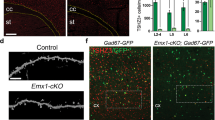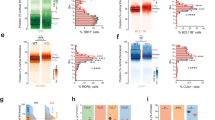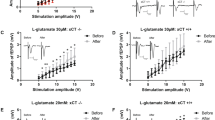Abstract
Some autistic individuals exhibit abnormal development of the caudate nucleus and associative cortical areas, suggesting potential dysfunction of cortico-basal ganglia (BG) circuits. Using optogenetic and electrophysiological approaches in mice, we identified a narrow postnatal period that is characterized by extensive glutamatergic synaptogenesis in striatal spiny projection neurons (SPNs) and a concomitant increase in corticostriatal circuit activity. SPNs during early development have high intrinsic excitability and respond strongly to cortical afferents despite sparse excitatory inputs. As a result, striatum and corticostriatal connectivity are highly sensitive to acute and chronic changes in cortical activity, suggesting that early imbalances in cortical function alter BG development. Indeed, a mouse model of autism with deletions in Shank3 (Shank3B−/−) shows early cortical hyperactivity, which triggers increased SPN excitatory synapse and corticostriatal hyperconnectivity. These results indicate that there is a tight functional coupling between cortex and striatum during early postnatal development and suggest a potential common circuit dysfunction that is caused by cortical hyperactivity.
This is a preview of subscription content, access via your institution
Access options
Subscribe to this journal
Receive 12 print issues and online access
$209.00 per year
only $17.42 per issue
Buy this article
- Purchase on Springer Link
- Instant access to full article PDF
Prices may be subject to local taxes which are calculated during checkout








Similar content being viewed by others
References
Shepherd, G.M.G. Corticostriatal connectivity and its role in disease. Nat. Rev. Neurosci. 14, 278–291 (2013).
Oldenburg, I.A. & Sabatini, B.L. Antagonistic but not symmetric regulation of primary motor cortex by basal ganglia direct and indirect pathways. Neuron 86, 1174–1181 (2015).
Difiglia, M., Pasik, P. & Pasik, T. Early postnatal development of the monkey neostriatum: a Golgi and ultrastructural study. J. Comp. Neurol. 190, 303–331 (1980).
Levine, M.S., Fisher, R.S., Hull, C.D. & Buchwald, N.A. Postnatal development of identified medium-sized caudate spiny neurons in the cat. Brain Res. 389, 47–62 (1986).
Tepper, J.M., Sharpe, N.A., Koós, T.Z. & Trent, F. Postnatal development of the rat neostriatum: electrophysiological, light- and electron-microscopic studies. Dev. Neurosci. 20, 125–145 (1998).
Kozorovitskiy, Y., Saunders, A., Johnson, C.a., Lowell, B.B. & Sabatini, B.L. Corrigendum: Recurrent network activity drives striatal synaptogenesis. Nature 489, 326–326 (2012).
Langen, M., Durston, S., Staal, W.G., Palmen, S.J.M.C. & van Engeland, H. Caudate nucleus is enlarged in high-functioning medication-naive subjects with autism. Biol. Psychiatry 62, 262–266 (2007).
Wolff, J.J., Hazlett, H.C., Lightbody, A.A., Reiss, A.L. & Piven, J. Repetitive and self-injurious behaviors: associations with caudate volume in autism and fragile X syndrome. J. Neurodev. Disord. 5, 12 (2013).
Langen, M. et al. Changes in the developmental trajectories of striatum in autism. Biol. Psychiatry 66, 327–333 (2009).
Langen, M. et al. Changes in the development of striatum are involved in repetitive behavior in autism. Biol. Psychiatry 76, 405–411 (2014).
Lord, C., Cook, E.H., Leventhal, B.L. & Amaral, D.G. Autism spectrum disorders. Neuron 28, 355–363 (2000).
DeLong, M. & Wichmann, T. Changing views of basal ganglia circuits and circuit disorders. Clin. EEG Neurosci. 41, 61–67 (2010).
Abrahams, B.S. & Geschwind, D.H. Advances in autism genetics: on the threshold of a new neurobiology. Nat. Rev. Genet. 9, 341–355 (2008).
Jiang, Y.H. & Ehlers, M.D. Modeling autism by SHANK gene mutations in mice. Neuron 78, 8–27 (2013).
Durand, C.M. et al. Mutations in the gene encoding the synaptic scaffolding protein SHANK3 are associated with autism spectrum disorders. Nat. Genet. 39, 25–27 (2007).
Gauthier, J. et al. Novel de novo SHANK3 mutation in autistic patients. Am. J. Med. Genet. B. Neuropsychiatr. Genet. 150B, 421–424 (2009).
Roussignol, G. et al. Shank expression is sufficient to induce functional dendritic spine synapses in aspiny neurons. J. Neurosci. 25, 3560–3570 (2005).
Arons, M.H. et al. Autism-associated mutations in ProSAP2/Shank3 impair synaptic transmission and neurexin-neuroligin-mediated transsynaptic signaling. J. Neurosci. 32, 14966–14978 (2012).
Han, K. et al. SHANK3 overexpression causes manic-like behavior with unique pharmacogenetic properties. Nature 503, 72–77 (2013).
Verpelli, C. et al. Importance of Shank3 protein in regulating metabotropic glutamate receptor 5 (mGluR5) expression and signaling at synapses. J. Biol. Chem. 286, 34839–34850 (2011).
Bozdagi, O. et al. Haploinsufficiency of the autism-associated Shank3 gene leads to deficits in synaptic function, social interaction and social communication. Mol. Autism 1, 15 (2010).
Yang, M. et al. Reduced excitatory neurotransmission and mild autism-relevant phenotypes in adolescent Shank3 null mutant mice. J. Neurosci. 32, 6525–6541 (2012).
Peça, J. et al. Shank3 mutant mice display autistic-like behaviours and striatal dysfunction. Nature 472, 437–442 (2011).
Wang, X. et al. Synaptic dysfunction and abnormal behaviors in mice lacking major isoforms of Shank3. Hum. Mol. Genet. 20, 3093–3108 (2011).
Harris, J.A. et al. Anatomical characterization of Cre driver mice for neural circuit mapping and manipulation. Front. Neural Circuits 8, 76 (2014).
Petralia, R.S. et al. Selective acquisition of AMPA receptors over postnatal development suggests a molecular basis for silent synapses. Nat. Neurosci. 2, 31–36 (1999).
Busetto, G., Higley, M.J. & Sabatini, B.L. Developmental presence and disappearance of postsynaptically silent synapses on dendritic spines of rat layer 2/3 pyramidal neurons. J. Physiol. (Lond.) 586, 1519–1527 (2008).
Khazipov, R. et al. Early motor activity drives spindle bursts in the developing somatosensory cortex. Nature 432, 758–761 (2004).
Carter, A.G., Soler-Llavina, G.J. & Sabatini, B.L. Timing and location of synaptic inputs determine modes of subthreshold integration in striatal medium spiny neurons. J. Neurosci. 27, 8967–8977 (2007).
Choi, S. & Lovinger, D.M. Decreased probability of neurotransmitter release underlies striatal long-term depression and postnatal development of corticostriatal synapses. Proc. Natl. Acad. Sci. USA 94, 2665–2670 (1997).
Moody, W.J. & Bosma, M.M. Ion channel development, spontaneous activity, and activity-dependent development in nerve and muscle cells. Physiol. Rev. 85, 883–941 (2005).
Kozorovitskiy, Y. et al. Neuromodulation of excitatory synaptogenesis in striatal development. eLife 4, e10111 (2015).
Sohur, U.S., Padmanabhan, H.K., Kotchetkov, I.S., Menezes, J.R.L. & Macklis, J.D. Anatomic and molecular development of corticostriatal projection neurons in mice. Cereb. Cortex 24, 293–303 (2014).
Colonnese, M.T. et al. A conserved switch in sensory processing prepares developing neocortex for vision. Neuron 67, 480–498 (2010).
Kilb, W., Kirischuk, S. & Luhmann, H.J. Electrical activity patterns and the functional maturation of the neocortex. Eur. J. Neurosci. 34, 1677–1686 (2011).
Etherington, S.J. & Williams, S.R. Postnatal development of intrinsic and synaptic properties transforms signaling in the layer 5 excitatory neural network of the visual cortex. J. Neurosci. 31, 9526–9537 (2011).
Gertler, T.S., Chan, C.S. & Surmeier, D.J. Dichotomous anatomical properties of adult striatal medium spiny neurons. J. Neurosci. 28, 10814–10824 (2008).
Kirkby, L.A., Sack, G.S., Firl, A. & Feller, M.B. A role for correlated spontaneous activity in the assembly of neural circuits. Neuron 80, 1129–1144 (2013).
Grabrucker, A.M. et al. Concerted action of zinc and ProSAP/Shank in synaptogenesis and synapse maturation. EMBO J. 30, 569–581 (2011).
Gogolla, N., Takesian, A.E., Feng, G., Fagiolini, M. & Hensch, T.K. Sensory integration in mouse insular cortex reflects GABA circuit maturation. Neuron 83, 894–905 (2014).
Martin, L.J. & Cork, L.C. The non-human primate striatum undergoes marked prolonged remodeling during postnatal development. Front. Cell. Neurosci. 8, 294 (2014).
Lewine, J.D. et al. Magnetoencephalographic patterns of epileptiform activity in children with regressive autism spectrum disorders. Pediatrics 104, 405–418 (1999).
Gonçalves, J.T., Anstey, J.E., Golshani, P. & Portera-Cailliau, C. Circuit level defects in the developing neocortex of Fragile X mice. Nat. Neurosci. 16, 903–909 (2013).
Bateup, H.S. et al. Excitatory/inhibitory synaptic imbalance leads to hippocampal hyperexcitability in mouse models of tuberous sclerosis. Neuron 78, 510–522 (2013).
Peñagarikano, O. et al. Absence of CNTNAP2 leads to epilepsy, neuronal migration abnormalities, and core autism-related deficits. Cell 147, 235–246 (2011).
Han, S. et al. Autistic-like behaviour in Scn1a+/− mice and rescue by enhanced GABA-mediated neurotransmission. Nature 489, 385–390 (2012).
Wolff, J.J. et al. Longitudinal patterns of repetitive behavior in toddlers with autism. J. Child Psychol. Psychiatry 55, 945–953 (2014).
Goldman, S. et al. Motor stereotypies in children with autism and other developmental disorders. Dev. Med. Child Neurol. 51, 30–38 (2009).
Goldman, S. & Greene, P.E. Stereotypies in autism: a video demonstration of their clinical variability. Front. Integr. Neurosci. 6, 121 (2012).
Harris, K.M., Mahone, E.M. & Singer, H.S. Nonautistic motor stereotypies: clinical features and longitudinal follow-up. Pediatr. Neurol. 38, 267–272 (2008).
Legéndy, C.R. & Salcman, M. Bursts and recurrences of bursts in the spike trains of spontaneously active striate cortex neurons. J. Neurophysiol. 53, 926–939 (1985).
Acknowledgements
We thank I. Oldenburg for help with in vivo recordings and analysis and J. Levasseur and R. Pemberton for mouse genotyping and colony management. We thank S. da Silva, C. Deister and the members of the Sabatini laboratory for helpful discussions and critical reading of the manuscript. R.T.P. was supported by the Alice and Joseph Brooks fellowship and the Nancy Lurie Marks clinical and research fellowship in autism. Y.K. was supported by the Leonard and Isabelle Goldenson Research Fellowship and the Nancy Lurie Marks Family Foundation. This work was supported by the National Institute of Neurological Disorders and Stroke (NS046579, to B.L.S.) and the Nancy Lurie Marks Foundation.
Author information
Authors and Affiliations
Contributions
R.T.P. and B.L.S. conceived the study and wrote the manuscript. R.T.P. carried out in vivo recordings and analyzed the data. R.T.P., W.W. and Y.K. carried out in vitro slice recordings and R.T.P. analyzed the data. D.M.C. performed the behavioral experiments and dendritic spine imaging and analysis.
Corresponding author
Ethics declarations
Competing interests
The authors declare no competing financial interests.
Integrated supplementary information
Supplementary Figure 1 Correlated oEPSC peak amplitude recorded at Vh=−70 and −20 mV.
Average oEPSC peak amplitude recorded in P14 SPNs of Rbp4-Cre;ChR2f/f mice at Vh=−70 and −20 mV. Note the linear relationship between oEPSCs recorded under the two conditions across a wide range of oEPSC amplitudes.
Supplementary Figure 2 Average cortical and striatal multi-unit responses to optogenetic stimulation of Rbp4-Cre;ChR2f/f mice.
(a) Peri-stimulus time histogram (5 ms bin) of APs fired by P10−11 (black) and P14−16 (red) cortical and (b) striatal units in response to extracranial optogenetic stimulation of Rbp4-Cre;ChR2f/f mice with 100 pulses of 473 nm light (blue rectangle). Shaded regions represent ± SEM. Arrows point to time bin with peak firing rate. Note the 5 ms shift in response latency of striatal units from P10−11 to P14−16.
Supplementary Figure 3 Similar presynaptic release properties in WT and Shank3B−/− SPNs across development.
(a) Example traces of eEPSCs evoked in SPNs of P14 WT and Shank3B−/− mice in response to paired electrical pulses (P1 and P2) with 50 ms ISI. (b) Mean ± SEM ratio of eEPSC amplitude in response to the paired stimulation pulses (P2/P1) in P14 and (c) P9 WT and Shank3B−/− SPNs.
Supplementary Figure 4 Increased Rbp4+ excitatory input onto Shank3B−/− SPNs during early development.
(a) Experimental diagram depicting whole cell recordings in P14 SPNs of dorsomedial striatum in acute brain slices of Shank3B−/−;Rbp4-Cre;ChR2-YFPf/wt mice and optogenetic fiber stimulation using whole field illumination (blue cone). Scale bar, 1 mm. (b) Representative traces of AMPAR oEPSCs recorded in SPNs of Shank3B+/− or Shank3B−/− mice under voltage clamp (Vh= -70 mV) in response to brief pulses of 473 nm laser light (blue rectangle). (c) Mean oEPSC peak amplitude ± SEM recorded in Shank3B+/− or Shank3B−/− SPNs. (d) Pair-wise comparison of average oEPSC amplitude in animals recorded in (c). Note that SPNs from Shank3B−/− animals have consistently larger oEPSC amplitude compared to SPNs from Shank3B+/− heterozygous littermates.
Supplementary Figure 5 Similar intrinsic excitability of WT and Shank3B−/− SPNs at P13−14.
(a) Mean ± SEM current-voltage (I-V) relationship in WT and KO SPNs. (b) Mean spike threshold potential (c) rheobase current (d) Vrest and (e) Current-firing rate (I-F) plot of WT and KO SPNs recorded at P13−14. Error bars represent ± SEM.
Supplementary Figure 6 Decreased locomotion of AAV-Cre injected vGATf/f mice.
(a) Heat map representing locomotion of vGATf/f mice (control) and vGATf/f littermates injected with AAV-Cre-EGFP (Cre) in an open chamber for 15 min. Color scale represents normalized time spent at each location. Scale bar, 10 cm. (b) Mean average velocity ± SEM of control and Cre injected vGATf/f animals. (c) Mean average time moving ± SEM of control and Cre injected vGATf/f animals. (d) Mean average total distance moved ± SEM of control and Cre injected vGATf/f animals.
Supplementary Figure 7 Similar PPR of eEPSC in SPNs of vGATf/f (control) and vGATf/f mice injected with AAV-Cre-EGFP.
(a) Example traces of eEPSCs evoked in SPNs of control and Cre-injected littermates in response to paired electrical pulses (P1 and P2) with 50 ms ISI. (b) Mean ± SEM ratio of eEPSC amplitude in response to the paired stimulation pulses (P2/P1).
Supplementary information
Supplementary Text and Figures
Supplementary Figures 1–7 (PDF 630 kb)
Rights and permissions
About this article
Cite this article
Peixoto, R., Wang, W., Croney, D. et al. Early hyperactivity and precocious maturation of corticostriatal circuits in Shank3B−/− mice. Nat Neurosci 19, 716–724 (2016). https://doi.org/10.1038/nn.4260
Received:
Accepted:
Published:
Issue Date:
DOI: https://doi.org/10.1038/nn.4260
This article is cited by
-
Shank3 deletion in PV neurons is associated with abnormal behaviors and neuronal functions that are rescued by increasing GABAergic signaling
Molecular Autism (2023)
-
A working taxonomy for describing the sensory differences of autism
Molecular Autism (2023)
-
Maturation of nucleus accumbens synaptic transmission signals a critical period for the rescue of social deficits in a mouse model of autism spectrum disorder
Molecular Brain (2023)
-
Activity-Dependent Differential Regulation of Auts2 Isoforms In Vitro and In Vivo
Molecular Neurobiology (2023)
-
iPSC toolbox for understanding and repairing disrupted brain circuits in autism
Molecular Psychiatry (2022)



